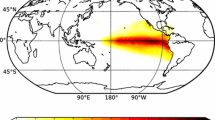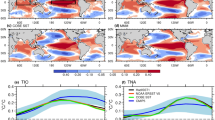Abstract
This study investigates the Intertropical Convergence Zone (ITCZ) response to extratropical thermal forcing applied to an atmospheric general circulation model coupled to slab ocean and land models. We focus on the relative roles of the atmosphere, tropical sea surface temperatures (SSTs) and continental surface temperatures in the ITCZ response to the imposed forcing. The forcing consists of cooling in one hemisphere and warming in the other poleward of 40°, with zero global average. Three sets of experiments are performed: in the first the slab ocean and land models are applied globally; in the second the tropical SSTs are kept fixed while the slab land model is applied globally; in the third, in addition, surface temperatures over Africa are kept fixed. Realistic boundary surface conditions are used. We find that the ITCZ shifts towards the warmer hemisphere and that the stronger the forcing, the larger the shift. When the constraint of fixed tropical SST is imposed we find that the ITCZ response is strongly weakened, but it is still not negligible in particular over the Atlantic Ocean and Africa where the precipitation anomalies are of the order of 20 and 60 %, respectively, of the magnitude obtained without the SST restriction. Finally, when the constraint of the African surface temperature is incorporated we find that the ITCZ response completely vanishes, indicating that the ITCZ response to the extratropical forcing is not possible just trough purely atmospheric processes, but needs the involvement of either the tropical SST or the continental surface temperatures. The clear-sky longwave radiation feedback is highlighted as the main physical mechanism operating behind the land-based extratropical to tropical communication.
















Similar content being viewed by others
References
Barreiro M, Philander SG (2008) Response of the tropical Pacific to changes in extratropical clouds. Clim Dyn 31:713–729. doi:10.1007/s00382-007-0363-5
Barreiro M, Fedorov A, Pacanowski R, Philander SG (2008) Abrupt climate changes: how freshening of the northern Atlantic affects the thermohaline and wind-driven oceanic circulations. Annu Rev Earth Planet Sci 36:33–58
Boccaletti G, Pacanowsk RC, Philander SG, Fedorov A (2004) The thermal structure of the upper ocean. J Phys Oceanogr 34:888–902. doi:10.1175/2008MWR2277.1
Burls N, Fedorov A (2014) What controls the mean east–west sea surface temperature gradient in the equatorial Pacific: the role of cloud albedo. J Clim 27:2757–2778. doi:10.1175/JCLI-D-13-00255.1
Chiang JC, Bitz CM (2005) Influence of high latitude ice cover on the marine Intertropical Convergence Zone. Clim Dyn 25:477–496. doi:10.1007/s00382-005-0040-5
Chiang JC, Friedman AR (2012) Extratropical cooling, interhemispheric thermal gradients, and tropical climate change. Annu Rev Earth Planet Sci 40:383–412. doi:10.1146/annurev-earth-042711-105545
Cvijanovic I, Chiang JC (2013) Global energy budget changes to high latitude North Atlantic cooling and the tropical ITCZ response. Clim Dyn 40:1435–1452. doi:10.1007/s00382-012-1482-1
Folland CK, Palmer TN, Parker DE (1986) Sahel rainfall and worldwide sea temperatures, 1901–85. Nature 320:602–607. doi:10.1038/320602a0
Giannini A, Saravanan R, Chang P (2003) oceanic forcing of Sahel rainfall on interannual to interdecadal time scales. Science 7:1027–1030. doi:10.1126/science.1089357
Gu DG, Philander SG (1997) Interdecadal climate fluctuations that depend on exchanges between the tropics and extratropics. Sci 275:805–807
Haarsma RJ, Selten FM, Weber SL, Kliphuis M (2005) Sahel rainfall variability and response to greenhouse warming. Geophys Res Lett 32:L17702
Hartmann DL (1994) Global physical climatology. International Geophysics Series, vol 56. Academic Press, San Diego, USA
Holton JR (2004) An introduction to dynamic meteorology, 4th edn. International Geophysics Series, vol 88. Academic Press, New York, USA
Hughen KA, Southon JR, Lehman SJ, Overpeck JT (2000) Synchronous radiocarbon and climate shifts during the last deglaciation. Science 290:1951–1954
Kalnay E et al (2006) The NCEP/NCAR 40-year reanalysis project. Bull Am Meteorol Soc 77:437–470
Kang SM, Held IM, Frierson DM, Zhao M (2008) The response of the ITCZ to extratropical thermal forcing: idealized slab-ocean experiments with a GCM. J Clim 21:3521–3532. doi:10.1175/2007JCLI2146.1
Kang SM, Frierson DM, Held IM (2009) The tropical response to extratropical thermal forcing in an idealized GCM: the importance of radiative feedbacks and convective parameterization. J Atmos Sci 66:2812–2827. doi:10.1175/2009JAS2924.1
Kucharski F, Molteni F, Bracco A (2006) Decadal interactions between the western tropical Pacific and the North Atlantic Oscillation. Clim Dyn 26:79–91. doi:10.1007/s00382-005-0085-5
Lin J-L (2007) The double-ITCZ problem in IPCC AR4 coupled GCMs: ocean-atmosphere feedback analysis. J Clim 20:4497–4525. doi:10.1175/JCLI4272.1
Liu Z, Yang H (2003) Extratropical control of tropical climate, the atmospheric bridge and oceanic tunnel. Geophys Res Lett. doi:10.1029/2002GL016492
Liu Y, Guo L, Wu G, Wang Z (2010) Sensitivity of ITCZ configuration to cumulus convective parameterizations on an aqua planet. Clim Dyn 34:223–240. doi:10.1007/s00382-009-0652-2
Lorenz DJ, Hartmann DL (2001) Eddy-zonal flow feedback in the southern hemisphere. J Atmos Sci 58:3312–3327
Lynch-Stieglitz J (2004) Hemispheric asynchrony of abrupt climate change. Science 304:1919–1920
Manabe S, Stouffer RJ (1995) Simulation of abrupt climate change induced by freshwater input to the North Atlantic ocean. Nature 378:165–167
Molteni F (2003) Atmospheric simulations using a GCM with simplified physical parametrizations. I. Model climatology and variability in multi-decadal experiments. Clim Dyn 20:175–191
Peterson LC, Haug GH, Hughen KA, Rohl U (2000) Rapid changes in the hydrologic cycle of the tropical Atlantic during the last glacial. Science 290:1947–1951
Rahmstorf S (1995) Bifurcation of the Atlantic thermohaline circulation in response to changes in the hydrological cycle. Nature 378:145–149
Schneider T, Bischoff T, Haug GH (2014) Migrations and dynamics of the intertropical convergence zone. Nature 513:45–53
Song X, Zhang GJ (2009) Convection parameterization, tropical Pacific double ITCZ, and upper-ocean biases in the NCAR CCSM3. Part I: climatology and atmospheric feedback. J Clim 22:4299–4315. doi:10.1175/2009JCLI2642.1
Stouffer RJ et al (2006) Investigating the causes of the response of the thermohaline circulation to past and future climate changes. J Clim 19:698–722
Sun D-Z, Zhang T, Shin S-I (2004) The effect of subtropical cooling on the amplitude of ENSO: a numerical study. J Clim 17:3786–3798
Uppala SM et al (2005) The ERA-40 re-analysis. Q J R Meteorol Soc 131:2961–3012. doi:10.1256/qj.04.176
Vellinga M, Woods RA (2002) Global climatic impacts of a collapse of the Atlantic thermohaline circulation. Clim Chang 54:251–267
Wang X, Auler A, Edwards RL, Cheng H, Cristalli PS, Smart PL, Richards DA, Shen C (2004) Wet periods in northeastern Brazil over the past 210kyr linked to distant climate anomalies. Nature 432:740–743. doi:10.1038/nature03067
Yang H, Liu Z (2005) Tropical–extratropical climate interaction as revealed in idealized coupled climate model experiments. Clim Dyn 24:863–879. doi:10.1007/s00382-005-0021-8
Acknowledgments
Part of this work was performed while the first author was supported by Grants from Universidad de la República and Agencia Nacional de Investigación e Innovación (ANII), Uruguay.
Author information
Authors and Affiliations
Corresponding author
Rights and permissions
About this article
Cite this article
Talento, S., Barreiro, M. Simulated sensitivity of the tropical climate to extratropical thermal forcing: tropical SSTs and African land surface. Clim Dyn 47, 1091–1110 (2016). https://doi.org/10.1007/s00382-015-2890-9
Received:
Accepted:
Published:
Issue Date:
DOI: https://doi.org/10.1007/s00382-015-2890-9




